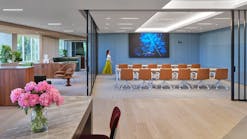Horticulture, indoor commercial, and home markets slam Signify
Signify today reported a 67.9% tumble in first quarter earnings and a 9.6% fall in sales as difficulties persisted in professional indoor lighting, the home market and OEM. Horticulture has for now slumped to become a “substantial detractor” but will rebound, CEO Eric Rondolat said.
On the positive side, the company said outdoor infrastructure projects were strong, such as with a smart street lighting project supplied to Huanggang City in China. And it continues to make good progress on its sustainability goals, including the introduction in the quarter of luminaires made from waste materials. And while the China market has yet to fully recover from earlier COVID restrictions, Signify said economic activity there increased.
But overall, just as Rondolat envisioned three months ago, global market volatility carried on tormenting the financial performance.
“Largely in line with our expectations, we continued to see persistent weakness in parts of our business, in the consumer segment and in the indoor professional business,” Rondolat said on a call with analysts today to discuss the earnings. “We also saw a constant slowdown our OEM sales,” he added, a reference to the products that Signify builds for other vendors.
Total company-wide sales for the quarter ending March 31 were €1.79 billion, marking a 6.1% nominal drop and a 9.1% comparable fall from €1.68 billion in the same quarter a year earlier. Net income was €28 million, down from €87 million a year ago. Adverse currency effects played a role in the downturn, as the company cited the Egyptian pound, a strong U.S. dollar, and the temporary effects of a new hedging policy. It also blamed what it described as “lower fixed cost absorption.”
The struggles have prompted a 6.7% reduction in the full-time workforce over the last year. Headcount was down to 34,408 at the end of the quarter, compared to 36,884 at the same time a year ago.
Again echoing remarks from earlier in the year, Rondolat said business could improve in the second half. “While we expect the remainder of H1 2023 to remain challenging, we continue to see the potential for an improved second half,” he noted.
Signify once again refrained from giving a sales forecast for 2023, as it did a quarter ago. Rondolat said the company remains committed to the guidance of achieving adjusted EBITA margins of between 10.5% and 11.5% for the year, and for 2023 free cash flow to be between 6–8% of sales.
No growth in growth
The company’s trouble areas include horticultural lighting, in which growers tap spectrally tuned LED lights (or older, untuned conventional lights) to grow crops indoors without sunlight, or to supplement natural light in greenhouses.
Horticulture is a vital growth area for the lighting industry in general. But vendors like Signify and ams Osram first started reporting a slowdown last fall, as growers balked at buying LED lighting — or artificial lighting of any sort — in the face of skyrocketing electricity prices. LEDs are energy efficient, but the cost of buying and running them in locations that have not used artificial lighting in the past has been dissuading customers. Ams Osram this week reiterated that horticulture remains slow; horticultural warning flares have become more common across the industry.
On his call with analysts today, Rondolat expressed hope that the horticultural sector would recover once energy prices settle down, and LEDs — in combination with other horticultural technology — will resume playing a bigger role in alleviating global food shortages by helping to grow crops near where they are needed, or in locations where it has not been possible to grow in the past.
When quizzed by one analyst on the effect that high electricity prices are having, Rondolat responded, “If you’re talking specifically about horticulture, it has been a big issue for us.”
Opening up on horticultural travails
Rondolat then opened up on the subject.
“First of all, our customers stopped investing because the price of electricity and the price of energy in general was such that those businesses could not be run profitably,” he said.
Some growers who had negotiated deals with electricity suppliers for 50% fixed rates and 50% variable rates “have basically stopped 50% of their production and continued only with the 50% where they had fixed prices,” he noted. “We’ve seen also some other customers in the horticulture segment that stopped producing their goods, whether it was flowers or vegetables, and used the fixed price that they had on the energy purchases to resell energy to others, preferring to make that their business.”
Indeed, as LEDs Magazine reported last June, Belgian tomato grower Tomerel has been reselling fixed rate electricity rather than using all of it for producing tomatoes. Tomerel is a customer of Signify’s Fluence division.
A horticultural comeback could be in sight.
“The price of electricity has gone down to levels that would ensure to these customers that they can run the business profitably,” Rondolat said. “But the volatility that we have seen in the past quarters is leading them to be very cautious.
“So the projects are there, the projects are lined up. But at this point in time there’s still a cautiousness in investment, and we see agriculture, at least in Q1, being again a quite substantial detractor in our professional business.
“We’ll see what the future brings. In the medium term to long term, that business will go back up. We need to find a substitute for food security. So there’s absolutely no issue directly when it comes to that business being a strategic one," Rondolat observed. "But in the meantime we have seen customers hesitating a lot and not investing given the volatility of the energy prices in the past quarters.”
High energy prices is one reason why Signify recently put out the message that growers can lower the LED electricity bill by avoiding white light in their photonic recipes.
Still in fluorescent
Signify and Rondolat touched on many other aspects of the company’s different sectors today, including the decline in indoor office lighting, which comes at a time when other European vendors like Fagerhult and Glamox are noting an improvement; on the fall-off in the home market; and on sustainability goals. Rondolat also provided some insights on how Europe’s fluorescent ban is affecting business at Signify, which unlike some other major European LED vendors is still in the fluorescent business. Signify’s LED lighting business includes both tubes and integrated luminaires, whereas some of its main European LED rivals sell only luminaires only — a difference which influences their approach to the ban, and which lighting remanufacturers are addressing.
LEDs will report on these in separate articles.
Notably, Signify made no mention of its UV-C business today, nor did it refer much to the IoT.
MARK HALPER is a contributing editor for LEDs Magazine, and an energy, technology, and business journalist ([email protected]).
Follow our LinkedIn page for our latest news updates, contributed articles, and commentary, and our Facebook page for events announcements and more. You can also find us on Twitter.

Mark Halper | Contributing Editor, LEDs Magazine, and Business/Energy/Technology Journalist
Mark Halper is a freelance business, technology, and science journalist who covers everything from media moguls to subatomic particles. Halper has written from locations around the world for TIME Magazine, Fortune, Forbes, the New York Times, the Financial Times, the Guardian, CBS, Wired, and many others. A US citizen living in Britain, he cut his journalism teeth cutting and pasting copy for an English-language daily newspaper in Mexico City. Halper has a BA in history from Cornell University.





